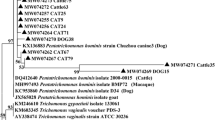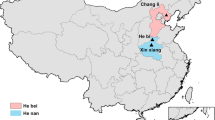Abstract
Pentatrichomonas hominis is an anaerobic amitochondrial flagellated protist that primarily colonizes the large intestines of a number of species, including cats, dogs, nonhuman primates, and humans. The prevalence of this parasite in dogs, monkeys, and humans is, however, poorly understood. In this study, a total of 362 fecal samples including 252 dogs, 60 monkeys, and 50 humans from northern China were collected for an epidemiological survey of P. hominis infection.The average prevalence of P. hominis infection determined by nested PCR was 27.38 % (69/252), 4.00 % (2/50), and 46.67 %(28/60) in dogs, humans, and monkeys, respectively. The prevalence was significantly higher in 6-month-old dogs (41.53 %) and children (7.69 %) than in older dogs (14.39 %) and adults (0 %) (P < 0.05). Sequencing of amplicons revealed that four variable positions separated sequences into three types, called CC1-3. CC1 was the most prevalent in the study population. This study determined that P. hominis infection is common in dogs, monkeys, and humans, especially in children and young dogs. Given the infection prevalence, P. hominis may pose a risk of zoonotic and anthroponotic transmission.

Similar content being viewed by others
References
Bell ET, Gowan RA, Lingard AE, McCoy RJ, Slapeta J, Malik R (2010) Naturally occurring Tritrichomonas foetus infections in Australian cats: 38 cases. J Feline Med Surg 12:889–898
Bellanger AP, Cabaret O, Costa JM, Foulet F, Bretagne S, Botterel F (2008) Two unusual occurrences of trichomoniasis: rapid species identification by PCR. J Clin Microbiol 46:3159–3161
Carter JE, Whithaus KC (2008) Neonatal respiratory tract involvement by Trichomonas vaginalis: a case report and review of the literature. Am J Trop Med Hyg 78:17–19
Crucitti T, Abdellati S, Buve A, Dyck E, Changalucha J, Ross DA (2004) Detection of Pentatrichomonas hominis DNA in biological specimens by PCR. Lett Appl Microbiol 38:510–516
Dimasuay KG, Rivera WL (2013) Molecular characterization of trichomonads isolated from animal hosts in the Philippines. VetParasitol 196:289–295
Frey CF, Schild M, Hemphill A, Stunzi P, Muller N, Gottstein B, Burgener IA (2009) Intestinal Tritrichomonas foetus infection in cats in Switzerland detected by in vitro cultivation and PCR. Parasitol Res 104:783–788
Geurden T, Thomas P, Casaert S, Vercruysse J, Claerebout E (2008) Prevalence and molecular characterisation of Cryptosporidium and Giardia in lambs and goat kids in Belgium. VetParasitol 155:142–145
Gookin JL, Stebbins ME, Hunt E, Burlone K, Fulton M, Hochel R, Talaat M, Poore M, Levy MG (2004) Prevalence of and risk factors for feline Tritrichomonas foetus and Giardia infection. J Clin Microbiol 42:2707–2710
Gookin JL, Stauffer SH, Coccaro MR, Marcotte MJ, Levy MG (2007a) Optimization of a species-specific polymerase chain reaction assay for identification of Pentatrichomonas hominis in canine fecal specimens. Am J Vet Res 68:783–787
Gookin JL, Stauffer SH, Levy MG (2007b) Identification of Pentatrichomonas hominis in feline fecal samples by polymerase chain reaction assay. VetParasitol 145:11–15
Grellet A, Brunopolack FA, Boucraut-Baralon C, Grandjean D, Vandewynckel L, Cian A, Meloni D, Viscogliosi E (2013) Prevalence, risk factors of infection and molecular characterization of trichomonads in puppies from French breeding kennels. Vet Parasitol 197:418–426
Jensen EA, Hammond DM (1964) A morphological study of trichomonads and related flagellates from the bovine digestive tract. JProtozool 11:386–394
Jongwutiwes S, Silachamroon U, Putaporntip C (2000) Pentatrichomonas hominis in empyema thoracis. Trans R Soc Trop Med Hyg 94:185–186
Kim YA, Kim HY, Cho SH, Cheun HI, Yu JR, Lee SE (2010) PCR detection and molecular characterization of Pentatrichomonas hominis from feces of dogs with diarrhea in the Republic of Korea. Korean J Parasitol 48:9–13
Kondova I, Simon MA, Klumpp SA, Mackey J, Widmer G, Dominques HG, Persenqiev SP, O’Neil SP (2005) Trichomonad gastritis in Rhesus macaques (Macaca mulatta) infected with simian immunodeficiency virus. Vet Pathol 42:19–29
Lewis KL, Doherty DE, Ribes J, Seabolt JP, Bensadoun ES (2003) Empyema caused by Trichomonas. Chest 123:291–292
Li WC, Gong PT, Ying M, Li JH, Yang J, Li H, Yang ZT, Zhang GC, Zhang XC (2014a) Pentatrichomonas hominis: first isolation from the feces of a dog with diarrhea in China. Parasitol Res 113:1795–1801
Li W, Li W, Gong P, Meng Y, Li W, Zhang C, Li S, Yang J, Li H, Zhang X, Li J (2014b) Molecular and morphologic identification of Pentatrichomonas hominis in swine. Vet Parasitol 202:241–247
Maritz JM, Land KM, Carlton JM, Hirt RP (2014) What is the importance of zoonotic trichomonads for human health? Trends Parasitol 30:333–341
Meloni D, Mantini C, Goustille J, Desoubeaux G, Maakaroun-Vermesse Z, Chandenier J, Gantois N, Duboucher C, Fiori PL, Dei-Cas E, Duong TH, Viscogliosi E (2011) Molecular identification of Pentatrichomonas hominis in two patients with gastrointestinal symptoms. J Clin Pathol 64(Goustille, J):933–935
Tolbert MK, Leutenegger CM, Lobetti R, Birrell J, Gookin JL (2012) Species identification of trichomonads and associated coinfections in dogs with diarrhea and suspected trichomonosis. Vet Parasitol 187:319–322
Wang HK, Jerng JS, Su KE, Chang SC, Yang PC (2006) Trichomonas empyema with respiratory failure. Am J Trop Med Hyg 75:1234–1236
Yang CR, Meng ZD, Wang X, Li YL, Zhang YX, Zhao QP (1990) Diarrhoea surveillance in children aged under 5 years in a rural area of Hebei Province. China J Diarrhoeal Dis Res 8:155–159
Acknowledgments
We thank our staff for their assistance with this study. This study was supported by the National Natural Science Foundation of China (grant number 30970322), the Major Program of Anhui Province Education Department (KJ2014ZD09), the Key Program of Anhui Province Education Department (KJ2015A189), the Key Program of Anhui Science and Technology University (ZRC2014406), and the Key Discipline Construction Program of Anhui Science and Technology University (AKZDXK2015A04).We declare that the experiments complied with the current laws of China at time of administration.
Author information
Authors and Affiliations
Corresponding authors
Additional information
Wen-Chao Li, Meng Ying and Peng-Tao Gong contributed equally to this work.
Rights and permissions
About this article
Cite this article
Li, WC., Ying, M., Gong, PT. et al. Pentatrichomonas hominis: prevalence and molecular characterization in humans, dogs, and monkeys in Northern China. Parasitol Res 115, 569–574 (2016). https://doi.org/10.1007/s00436-015-4773-8
Received:
Accepted:
Published:
Issue Date:
DOI: https://doi.org/10.1007/s00436-015-4773-8




